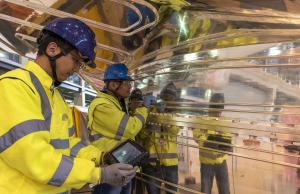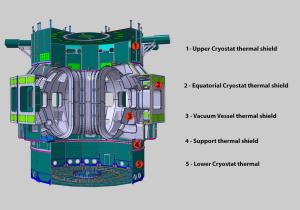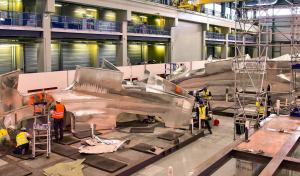Where are we at?
Fitting the vacuum vessel sectors like a jacket, lining the inner wall of the cryostat, or covering the sides of vertical coil gravity supports, ITER's thermal shield panels act as a barrier preventing heat transfer to the ultra-cold superconducting magnets. Thermal shield panels cover a surface of approximately 4,000 m² and are actively cooled by way of a network of small-diameter pipes welded to their surface. In November 2021, tiny cracks were identified in the piping of three yet-uninstalled vacuum vessel thermal shield panels. Considering that the issue could be systemic, the decision was taken to remove and replace all cooling pipes (23 kilometres in total) and, in some cases, opt for a new attachment technique.
Two years and a few months later, a lot has already been achieved. Of the nine "assembly units" of vacuum vessel thermal shield (each comprising one inboard and two outboard segments), two sets were sent to India for repair by ITER Organization contractor INOX-CVA. The first panels are travelling back to ITER and, in December, a contract was signed for the repair of three additional units. "At INOX-CVA, the piping is removed, the panel surface is machined, and new piping is welded," explains Chang Hyun Noh, the acting leader for the ITER Vacuum Vessel Thermal Shield and Cryostat Project. "During the machining process, the original silver coating is removed from under the pipe path. This eliminates the need for the chlorine rinsing that contributed to the stress corrosion cracking problem."
In order to mitigate the risk of panel deformation due to the removal and re-welding of the cooling pipes, the ITER Organization has asked a Korean company, SamHong Heavy Machinery, to manufacture two additional vacuum vessel thermal shield assembly units. Ultra-high polishing of the panels' surface, rather than silver coating, will simplify the manufacturing process while ensuring "similar performance" in terms of thermal emissivity.
Meanwhile, in the partly vacated poloidal field coil winding facility on site, the remaining sets of vacuum vessel thermal shield are being inspected and tested for corrosion cracking. Only the panels without the presence of deep ongoing corrosion cracking, namely with very small and superficial defects, are being shipped for repair in India," says Chang Hyun.
Last year, the support thermal shield panels, which provide a thermal barrier to the 18 toroidal field coil gravity supports, were removed from the machine assembly pit. Their relatively low weight (730 kg per unit) and simple, rectangular shape, make them easier to deal with. Piping was removed from the panels, and they were sent for machining to a contractor near Lyon, France. Once machining—a process that removes approximately 2 mm of material—is complete, the panels will be returned to ITER and new piping will be welded under the responsibility of ITER TAC-1 assembly contractor, CNPE.
The lower cryostat thermal shield, which was installed in January 2021, presents a more daunting challenge. Due to space and cleanliness constraints inside the assembly pit, removing and re-welding cooling pipes has been ruled out. Instead, a new set of piping will be clamped to the component's surface. However, as long as poloidal field coils #5 and #6 remain in their present, temporary position, part of the lower cryostat thermal shield is inaccessible. Repairs will be finalized only when the coils are lifted into their final position.
Other parts of the machine's thermal shield—for example the equatorial and upper cryostat thermal shields that were delivered in 2021 and are currently stored by ITER's global logistics provider DAHER in a large warehouse close to Marseille's industrial harbour—will be preventively repaired. Technical specifications are under preparation, reflecting lesson learned from vacuum vessel thermal shield repair and a call for tender will be launched soon.
Chang Hyun aims to have support thermal shield repair finalized by early 2025 and vacuum vessel thermal shield repair finalized by the first quarter of 2026. As for the lower cryostat thermal shield, the schedule is dependent on the repositioning of poloidal field coils #5 and #6 once all 18 toroidal field coils are in place.




